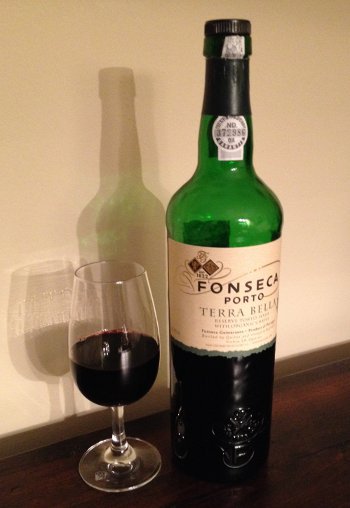Alright, deep breath, drastic simplification of a complicated booze category incoming: Port is a fortified wine made by adding a neutral grape spirit (similar to Brandy) to the wine during the middle of the fermentation process. This raises the alcohol and halts the fermentation process, leaving residual sugars and thus resulting a sweeter taste (which is why this is often referred to as a “dessert wine”). Port originates from a specific region in Portugal and it’s a protected appellation (like Champagne, etc…)
While the terroir and grapes used are important (and there are multiple varietals), the bigger lever in the Port world appears to be how it is aged. I’m totally going to screw this up, but what you’ve got are basically Tawny Ports and Ruby Ports (and I guess I should include White Ports, which are made with white graps). Both are typically aged in wooden barrels, but Tawny Ports will age for much longer and often come with an Indication of Age (a term of the art, with official designations 10, 20, 30, and 40 years). Aging in barrels exposes the wine to a long, gradual oxidation and evaporation, leading to a loss of color (typically settling into a golden brown color) and differences in flavor. Because the aging is done in the barrel, the bottle is usually ready to drink when you buy it.
Ruby Port, on the other hand, typically spends a shorter amount of time in the barrel and is meant to age in the bottle. To be sure, most Ruby Port is not necessarily meant for extended aging, but there are many sub-categories here. Ruby, Reserve, Late Bottled Vintage (LBV), Vintage, and several others exist. We’ll cover LBV and Vintage in a separate post, but Vintage port is supposedly the finest Port you can have. Ruby is typically a blend of very young Port, simple and fruit-driven flavors. Reserve Port is a blend of Ruby Ports with an older average age and thus added complexity and quality. The idea is to approximate some of the character of Vintage port through blending.
There are, of course, a bunch of other styles that could be added to this list, but we’ll stop now before we anger the wine gods any further with our pitiful summaries of complex subjects. What we have today is a Reserve Porto from Fonseca, who makes the seemingly ubiquitous Bin 27, also a Reserve blend. The difference between Terra Bella (aka Terra Prima) and Bin 27 is that Terra Bella is made with certified organic grapes. Go Fonseca. Alas, I think this falls a bit short of my gold standard Reserve, which is Graham’s Six Grapes (a little more expensive, but still in the $20ish range and worth the stretch):

Fonseca Terra Bella Reserve Porto – Pours a very dark red, purple color (I feel like this is darker than normal, but then, it’s not like I took pictures or really studied most of my previous Portos). Smell has a big fruit profile, plums, grapes, and the like, some oak, maybe even a sorta earthy tobacco kinda thing, but now I’m kinda pushing my limited wine palate. Taste is rich and sweet, less fruit than the nose, but it’s there. That earthy tobacco stuff that I was reaching for in the nose is here in the taste too. The booze also comes through strong in the finish. Mouthfeel is rich and full bodied, with a bit of hot booze in the finish (I want to say it’s hotter than most ports). Overall, it’s a solid take on the Porto, though I found the balance a bit off. B
Wine Nerd Details: 20% ABV bottled (750 ml cork stopper). Drank out of a copita glass.
Beer Nerd Musings: I was originally turned on to Port Wine because some beers, particularly very high ABV beers, are often described as having a Port Wine character to them. In specific, Dogfish Head’s World Wide Stout, an 18% ABV monster imperial stout, was described by Sam Caligione as having “port notes” which I noted at the time made me want to check out the world of port.
And here we are a few years later, and I can certainly discern a port-like character in some beers, particularly high ABV, malt-forward barleywines, which often take on a vinous fruit character (even though there are no grapes used in their production), some examples being Dock Street’s Barleywine and Hoppin’ Frog’s Naked Evil, though you’ll often see fruity notes mentioned in barleywine reviews. Stouts are a little more rare, but the very high ABV ones like the aforementioned WWS and Brewdog Tokyo.
And there are, of course, Port barrel aged beers, though my luck with them has been decidedly mixed. The La Trappe Quadrupel Barrique was partially aged in Port barrels and turned out fantastic (but I’m not sure I’d call it better than the base beer). On the other hand, JW Lees Harvest Ale and Scotch De Silly were both aged in Port barrels and turned out rather horrid. However, I think the fault there lies with the European tendency to appreciate small amounts of diacetyl in their beer, while I have not tolerance for that whatsoever. So I can’t really blame the Port barrels for that. Otherwise, it’s not a treatment we see super often in the US. I imagine shipping the barrels over from Portugal would be an expensive hassle, but some brewers manage. Hill Farmstead has a variant on Damon that’s aged in Port barrels that gets amazing reviews. There are plenty of other beers aged in Port barrels, but they seem rather rare. I will need to keep an eye out for them…
So there you have it. A small glass of Port Wine has become a Kaedrin nightcap standard, and it’s often a nice way to follow up some beer. Oh, and it’s good on its own too. Stay tuned for Beer Club tomorrow, followed by some Vintage Port on Thursday.